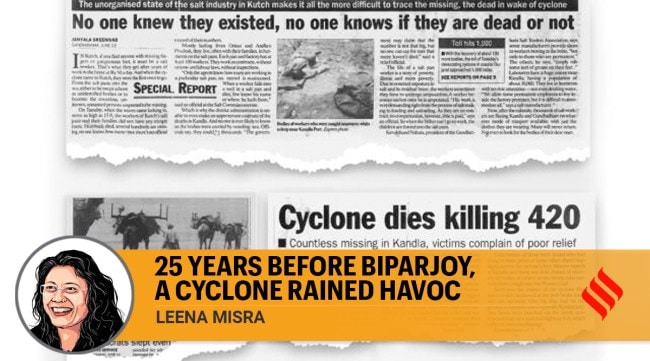Opinion 25 years before Biparjoy, a cyclone rained havoc
Mihir Bhatt, founder of the All-India Disaster Mitigation Institute (AIDMI), an Ahmedabad-based NGO who was in Kutch a day after the cyclone hit, recalls how “everything seemed cleaned up”.
 The Indian Express’s coverage of the 1998 cyclone. Express Archives
The Indian Express’s coverage of the 1998 cyclone. Express Archives “It was not a cyclone, it was a tsunami,” says former Chief Minister Suresh Mehta, who was Gujarat Industries Minister in 1998, describing how a “2,000-tonne ship climbed onto the shore riding the waves and had to be eventually scrapped as it could not be pushed back”.
While Biparjoy, the latest ‘very severe cyclonic storm’ to hit the Gujarat coast, seems to have lost steam, with the India Meteorological Department (IMD) saying it has turned into a “deep depression”, the uneasy wait for the cyclone brought back memories of another cyclone, 25 years ago, that battered Kutch and left a trail of death and destruction in its wake.
The ‘very severe cyclonic storm’ hit the Gujarat coast on June 9-10, 1998, with a speed of 167 kmph, impacting the districts of Porbandar, Jamnagar and Kutch and killing thousands. While a Ministry of Home Affairs (MHA) report recorded the official death toll at 1,680, it is believed that the numbers could have been much higher as many bodies that were flung into the sea could not be traced.
A June 11, 1998, report in The Indian Express read: “Sea water flooded the entire town, entered the first floor (of) houses in the multi-storey Kandla Port Trust (KPT) residential colony forcing people to move higher up. The tidal water was two metres high at the power jetty. A mammoth petrol tank of an oil company was upturned. The Kandla Salt Works, which is Asia’s biggest, vanished without a trace.”
Many of those who died were migrants from as far as Odisha, Andhra Pradesh and Uttar Pradesh – labourers working at the Kandla Port or in the salt factories. “Bodies, shovelled into trucks, were taken out, drenched with diesel and burnt in the open…”, read another report of June 12, 1998, that appeared in The Indian Express. Eyewitnesses say bodies surfaced later at ports and in salt factories. Many were swept away and their bodies were not found. “Only bodies of those were found who had clung to trees, poles or some other objects hoping to survive the cyclone’s fury,” read a June 11 report.
Officials who were part of the Keshubhai Patel-led government then recall that the storm that “seemed to have blown over” returned with increased ferocity.
Pravin Laheri, then principal secretary to chief minister Keshubhai Patel, recalls how the cyclone had “changed course” and caught state authorities unawares. “Vajubhai Vala (then finance minister) had already announced that the cyclone had blown over, but once it reached Jodiya (in Jamnagar district), it began to intensify. The intensity grew once it reached the Gulf of Kutch,” recalls Laheri, calling it a “freak incident”.
“In fact, thinking that the cyclone had blown over, Kandla Port had begun operations… those days the weather alert systems were not as sophisticated as they are today,” he adds.
Laheri describes the sea inundating the salt pans “like a tsunami” and recalls how a student of National Institute of Technology (NIFT) lost her father on a merchant vessel that sank near Salaya port in Dwarka.
An IMD report from then states that the “system” maintained its intensity as a very severe cyclonic storm “even after crossing the coast till noon when it lay over the Gulf of Kutch about 50 km south west of Kandla at 9 hrs of June 9” before it weakened. According to the IMD report, 1,173 people died and 1,774 persons were reported missing.
Retired IAS officer and the then finance secretary KV Bhanujan recalls how “the data we received did not show the cyclone path including Kutch…it was very unexpected. Also the technology was not as advanced those days. Today you get (alerts) very promptly”.
The cyclone also inflicted huge losses. A publication by the MHA, ‘Disaster, Risk Management and The Role of Corporate Sector’, notes how the cyclone of 1998, “ripped through the industrial heart of Gujarat and inflicted an economic loss of nearly Rupees 2,500 crores. The Kandla Port, gateway to the granaries of north India and the industrial belt of west and north India, and neighboring facilities suffered extensive damage and a loss of nearly (Rs)600 crores.
The corporate sector including Reliance Industries’ Jamnagar oil refinery suffered losses amounting to Rupees 100 crore and Gujarat State Fertilizer Corporation’s output was disrupted to the tune of 2,000 tonnes per day. The wind lifted the heavy cranes and machinery and twisted the transmission towers”.
Laheri recalls that handling the compensation process was complicated. “Those days there was no Aadhaar card (for identification)…about 500 of them had ration cards as proof… Also, most of the bodies had started rotting and were beyond recognition,” he says.
Mihir Bhatt, founder of the All-India Disaster Mitigation Institute (AIDMI), an Ahmedabad-based NGO who was in Kutch a day after the cyclone hit, recalls how “everything seemed cleaned up”. “I have never seen so many roofless structures. There was complete devastation…people had been swept away, there were bodies, some embedded in the beach sand,” says Bhatt.
The other memory Bhatt has is of the “large number of people walking back from Kandla, it was like a caravan… returning to their homes in the tribal belts”.





